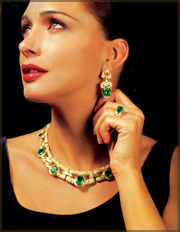|
observer |
|
|
|
|
|
OTHER LINKS |

|

|

|
Inspiration and imaginationGold continues to mesmerise and captivate, and whatever Your taste, Unsurpassed designs And craftsmanship It's impossible not to be captivated by gold jewellery, whether it's the simplistic, elegant lines of European jewellery or the intricately-fashioned patterns of oriental jewellery. Jewellery designing is an art form both in the Orient and the West, the difference being that in the Orient, the art is passed down from generation to generation. A son learns the necessary skills from his father as his father did before him. Even the designs are handed down with little or no structural changes.
In the West, jewellery designing is more technical, with many avenues for formal training. Perhaps Arabic and Indian jewellery, both drawing inspiration from their uniquely stimulating and distinct environments, are the most intriguing of all Oriental jewellery. Indian gold jewellery unashamedly borrows from the striking structures of intricately patterned leaves and stunning floral forms; leaves and floral motifs are common. Even the abundant variety of fruit trees are represented. Of these the mango, the king of fruits, has commanded maximum attention from traditional Indian jewellery designers, and it forms one of the most common of all motifs. Indian jewellery designs also draw from the spectacular animal kingdom, featuring lions, elephants, and tigers. Brilliantly coloured songbirds are portrayed, and the bird that can only be described as living art, the peacock, figures again and again, adorning bracelets, chains, pendants and rings. Indian jewellery is chunky, yet intricately patterned, with the elements of both land and sea abundant in designs. The other common motifs that find a place in gold jewellery are a myriad of fish, exquisitely shaped shells, delicately sculptured snails and watersnakes. Depending on the region of origin, Indian gold jewellery can reflect the rustic, earthy and colourful life of the rural Indian. In fact ethnic jewellery has now gained acceptance throughout India, perhaps reflecting a desire to stay in touch with one's roots. Modern interpretationThe Middle East has traditionally been a land of astronomers, star-gazers, and seafarers. The stars and the moon feature prominently in Arabic culture, and 21-carat gold jewellery with its rich lustre and versatility lends itself marvellously to the arabesque designs of stars and the crescent moon. Inspiration for Arabic jewellery is also derived from the landscape - the dynamic patterns formed by the wind on desert dunes, the footprints of camels, the sturdy plants and desert flowers, the falcon, the rich sea life, as well as everyday objects and images such as the samovar, traditional dagger and the dhows. Arabic jewellery is hardly, vigorous, bold and striking, a true reflection of desert life. Although the motifs of Arabic jewellery have remained unchanged for centuries, recent years have seen the interpretation of these motifs in a more modern graphic style. The same can also be said of 22 carat Indian jewellery. When a group UAE nationals were asked to rank four categories of jewellery in order of preference, 61 per cent ranked modern designs in high carat (21-24) jewellery as their first choice. Traditional UAE gold jewellery designs were ranked a weaker second, with just 19 per cent of the group choosing it. Traditional designs of other cultures in high cartage was ranked third (12 per cent) and modern designs of 14-18 carat was ranked last (8 per cent). Said Pedro Bertran, World Gold Council Manager of Middle East and India: Modernity doesn't necessarily mean changing to the Western jewellery styles, rather it could imply the modern interpretation of classical jewellery designs. Keeping in mind the research findings, we have now started to prepare an Arab and Indian gold jewellery design trend book. The book will be a source of inspiration for Arabic and Indian jewellery designers." The crafting of European jewellery follows well-defined guidelines and is dictated by current fashion trends. The Essential trends has two distinct features - satin-finished or worked surfaces that contrast sharp geometric shapes with clearly defined edges and decisive lines. If the material is highly polished, there will be more highlights and greater volume to ensure that line remains the main feature. The essential value is the balance between form and function. The Electric trend aims to arouse attention, create surprise and stir emotions. The jewellery is passionate, alive and original. It may seem avantgarde, expressing the designs of the future, and may draw inspiration from social costumes, dominant passions, unusual and artistic ideas. Emphasis is on the use of colour, on alternative materials to match with gold, on exuberant and eccentric forms and on new ways of wearing the jewellery. The Mediterranean trend reflects an individual's desire to escape, into the nostalgic dream world of memories, or into the reality of a journey to a land far from civilisation. On one hand there is the desire for contact with nature and life in the countryside with its simplicity and its rhythms. On the hand, exotic travel: contact with or exploration of places where poverty is compensated by richness of the primary values of existence. Mediterranean means light and colour, vibrations and sensuality, folklore and folk art, with a theme of a spontaneous nature. Ancient civilisations have showered this trend with its symbols: the olive and the vine, the sky and stars, fish and birds, fruits and seeds, hearts and flowers, all of which are sources of inspiration. |








